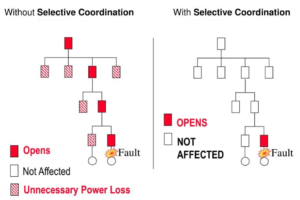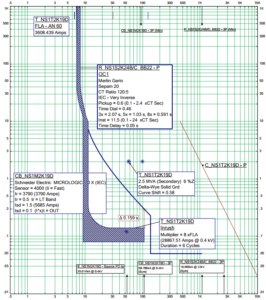The power system faces many impacts that cause instability and reduce reliability from the actual operation process caused by short circuits or discharges between energized phases or the ground system or by sudden load increases, loss of synchronization and excessive load usage that overloads the system’s tolerance due to increased demand for electrical energy, in addition to being affected by natural factors such as lightning. In particular, with the development, use and increasingly connecting distributed power sources to the existing power system, the structure of the power system has changed and caused negative impacts on power quality and reliability of the power system. Protection device coordination analysis is to analyze, calculate, and evaluate the protection system of the power system against abnormalities to ensure that the protection devices operate properly, isolate and quickly eliminate incidents, minimize widespread power outages that disrupt production activities, protect equipment, and minimize arc energy to protect operators.
♦ System protection coordination is one of the most basic and essential features of a power system. Accordingly, the function of system protection is to quickly detect and isolate the affected part of the system whenever a short circuit or other abnormality occurs that could cause damage or adversely affect the operation of any part of the system or the loads supplied by the system. Coordination is the selection and setting of protective devices to isolate only the part of the system where the abnormality occurs without affecting other systems. The following are the objectives of protection device coordination analysis:
– Operator safety: prevents injury and death.
– Equipment protection: allows normal operation, isolates equipment in abnormal conditions.
– Selectivity: minimally isolates the electrical system with abnormal conditions, allowing normal operation for the rest of the electrical system.
– Reliability: ensures maximum reliability and minimum cost
– Stability: balances between system sensitivity and stability.


♦ Conducting protective device coordination analysis provides information for the following purposes:
– Conducting protective device coordination under different operating conditions and scenarios.
– Conducting protective device coordination according to pre-established criteria and standards.
– Protective device curve characteristics and device failure characteristics are shown on visual current and time diagrams.
– The operating sequence of protective devices is simulated according to the actual calculated short-circuit current.
♦ Applicable standards
– IEEE 242 Protection Device Coordination Standard
– IEEE 3004 Protection Device Coordination Standard
– IEEE C37.96 Motor Protection Standard
– IEEE C37.91 Transformer Protection Standard
– IEEE C37.102 Generator Protection Standard

